Project Kickoff Meeting: How to Start Right + Free Calendar Template
Learn what to include in a project kickoff meeting, how to prepare effectively, and download a free template to organize your next project start.
Every successful project starts with a solid project kickoff meeting — the moment when goals, people, and plans come together. It’s more than a formality; it’s where alignment, clarity, and motivation begin.
A good kickoff sets expectations, prevents confusion, and builds early momentum.
In this guide, we’ll walk you through what a project kickoff is, how to run an effective project kickoff meeting, what to include in your agenda, and how to prepare, plus, you can download a free calendar template to make planning even easier.
What is a Project Kickoff?
A project kickoff is the official start of a project — the moment when all the preparation, approvals, and planning come together to launch real work. It signals that the team is ready to move from planning to execution.
At this stage, the focus shifts from ideas and documentation to action. The project manager gathers the team, reviews the goals, and ensures everyone understands their roles and what success looks like.

A strong project kickoff helps to:
- Align the team on objectives, deliverables, and timelines
- Clarify roles and expectations so responsibilities are clear from day one
- Confirm the project scope and priorities to avoid miscommunication later
- Build motivation and ownership by connecting everyone to the project’s purpose
In short, the project kickoff lays the foundation for how the team will work together. It’s where momentum begins — and where small details, if left unclear, can make a big difference later.
Read also: Understanding the 5 Stages of the Project Lifecycle
What is a Project Kickoff Meeting?
A project kickoff meeting is the first formal meeting that brings everyone involved in a project together — from the core team to project stakeholders and, in some cases, clients. It’s the moment when the team officially starts the journey toward the project’s goals.
The purpose of this meeting is simple: to make sure everyone understands what the project aims to achieve, how it will be done, and who’s responsible for what. It’s also a chance to build relationships and set the right tone for collaboration.
There are generally two types of kickoff meetings:
- Internal Kickoff Meeting: Held with the internal project team to align on strategy, tools, roles, and timelines before client-facing work begins.
- External (Client) Kickoff Meeting: Involves clients or external partners, focusing on expectations, deliverables, and communication plan between all parties.

A well-run kickoff meeting helps prevent confusion later by addressing questions early, ensuring everyone is aligned on the same goals, and creating a shared understanding of success.
In short, it’s not just a meeting — it’s your team’s launch pad. Done right, it builds confidence, clarity, and momentum before the first task even begins.
What Is The Purpose of a Kickoff Meeting?
The main goal of a project kickoff meeting is to make sure everyone starts with the same understanding, who’s involved, what needs to be achieved, and how the team will get there together. It sets the tone for collaboration, accountability, and shared ownership right from day one.
Here’s what a strong kickoff meeting should accomplish:
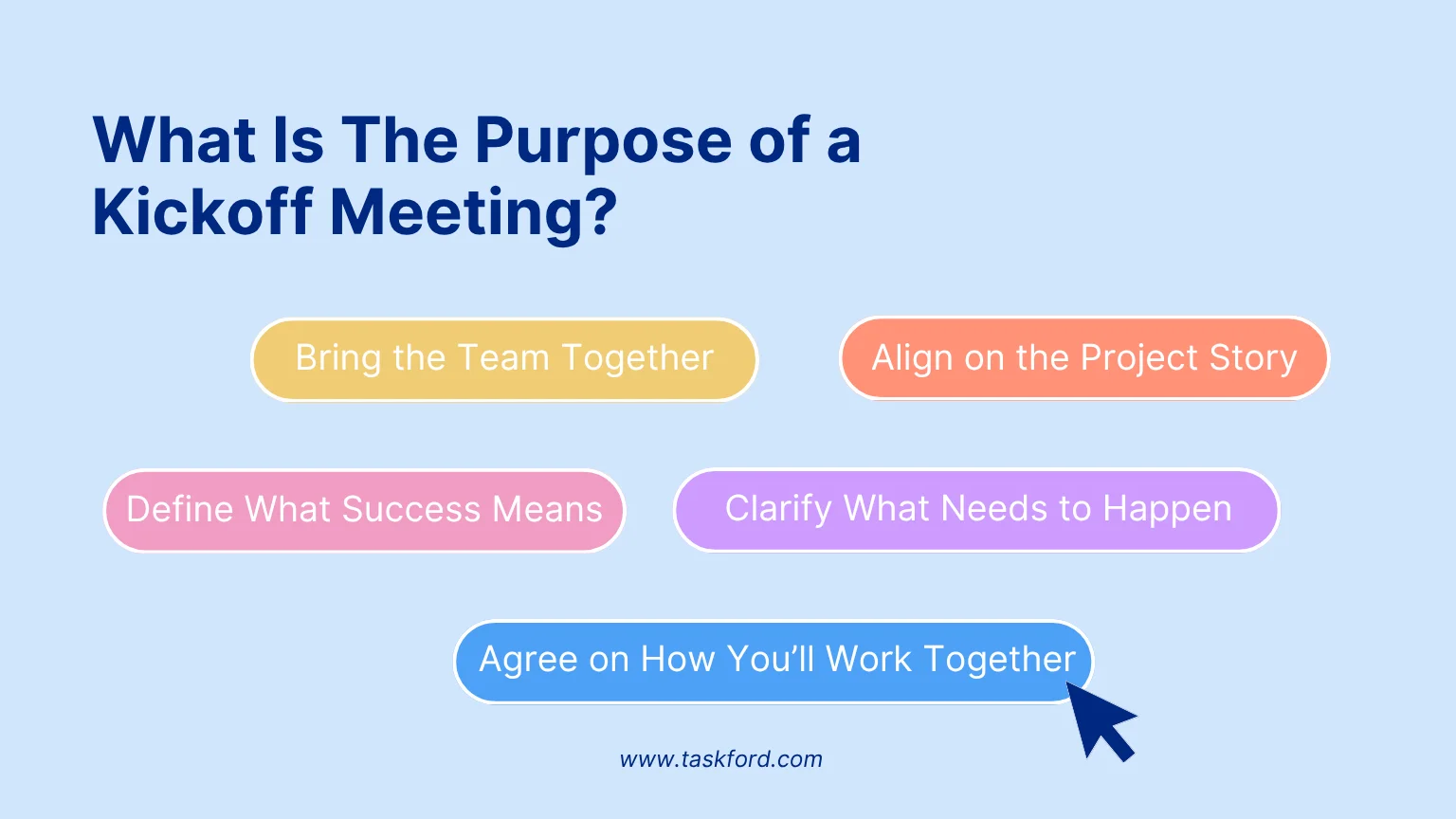
- Bring the Team Together It’s the first chance for everyone to meet and connect, especially when team members come from different departments or functions. This helps build rapport and a sense of partnership before work begins.
- Align on the Project Story Go over the background and reason behind the project. Understanding the “why” — the challenge being solved or the opportunity being captured — helps the team stay motivated and aligned with the bigger picture.
- Define What Success Means Paint a clear picture of what a successful outcome looks like. Whether it’s meeting deadlines, hitting targets, or delivering a client-ready solution, having a shared definition of success keeps everyone focused on the same end goal.
- Clarify What Needs to Happen Outline the project scope, priorities, and deliverables. This helps the team understand exactly what’s expected and avoids confusion or overlap later on.
- Agree on How You’ll Work Together Decide on how communication, updates, and collaboration will flow. Set expectations for tools, check-ins, and approvals, so everyone knows how to stay in sync throughout the project.
Read also: Cross-Functional Collaboration Cut Delivery Time by 30%
When done well, a kickoff meeting doesn’t just launch a project; it creates momentum, trust, and shared purpose. It’s where alignment turns into action, setting the entire team up for a smoother path ahead.
What to Include in a Project Kickoff Meeting Agenda
A focused project kickoff meeting agenda keeps everyone aligned without overloading the session. The goal is to cover what matters most — purpose, people, plan, and next steps.
A good agenda doesn’t need to be long; it just needs to create shared clarity and momentum. Here’s how to structure it effectively:

1. Welcome and Introductions
Start your meeting with a warm welcome and quick introductions. Whether you’re meeting in person or virtually, this helps the team get comfortable and understand who’s who.
Ask each participant to briefly share their name, role, and what part they’ll play in the project. For larger groups, you can keep it short by having department leads introduce their teams.
2. Project Overview
Provide a clear snapshot of the project, its goals, scope, and timeline. This is where you answer the big questions:
- What is the project about?
- Why are we doing it?
- What will success look like?
Give context around how this project supports broader company or client goals. Keep it concise but informative; your goal is to align understanding, not dive into every detail.
Read also: How to create a project plan [10 Steps Included]
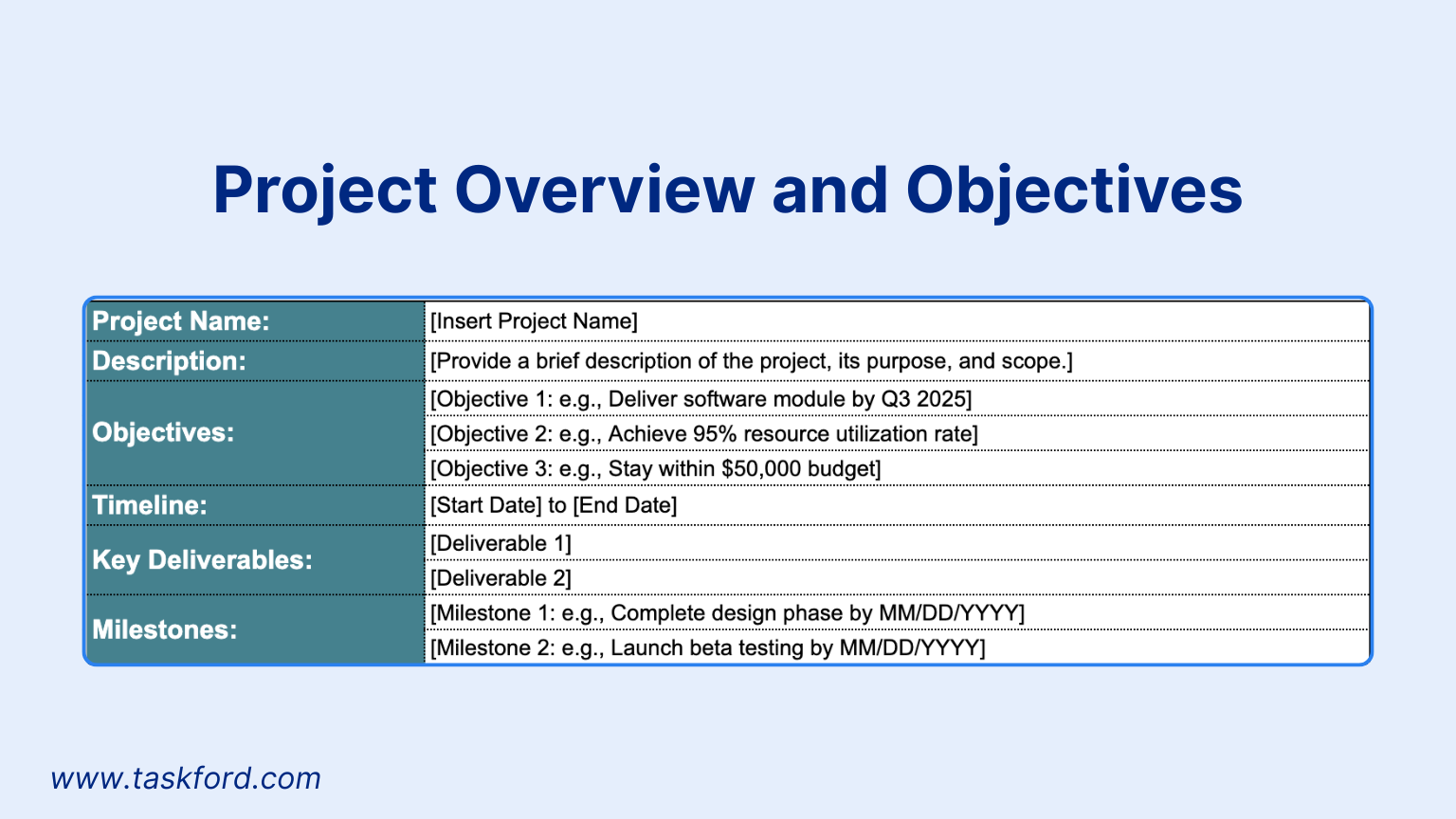
3. Key Deliverables and Milestones
Outline the major project deliverables and important deadlines. These are the tangible outcomes that define progress: prototypes, reports, campaign launches, product releases, etc.
Show the key project milestones or checkpoints on a simple timeline to help everyone visualize the flow of work and where major handoffs happen.
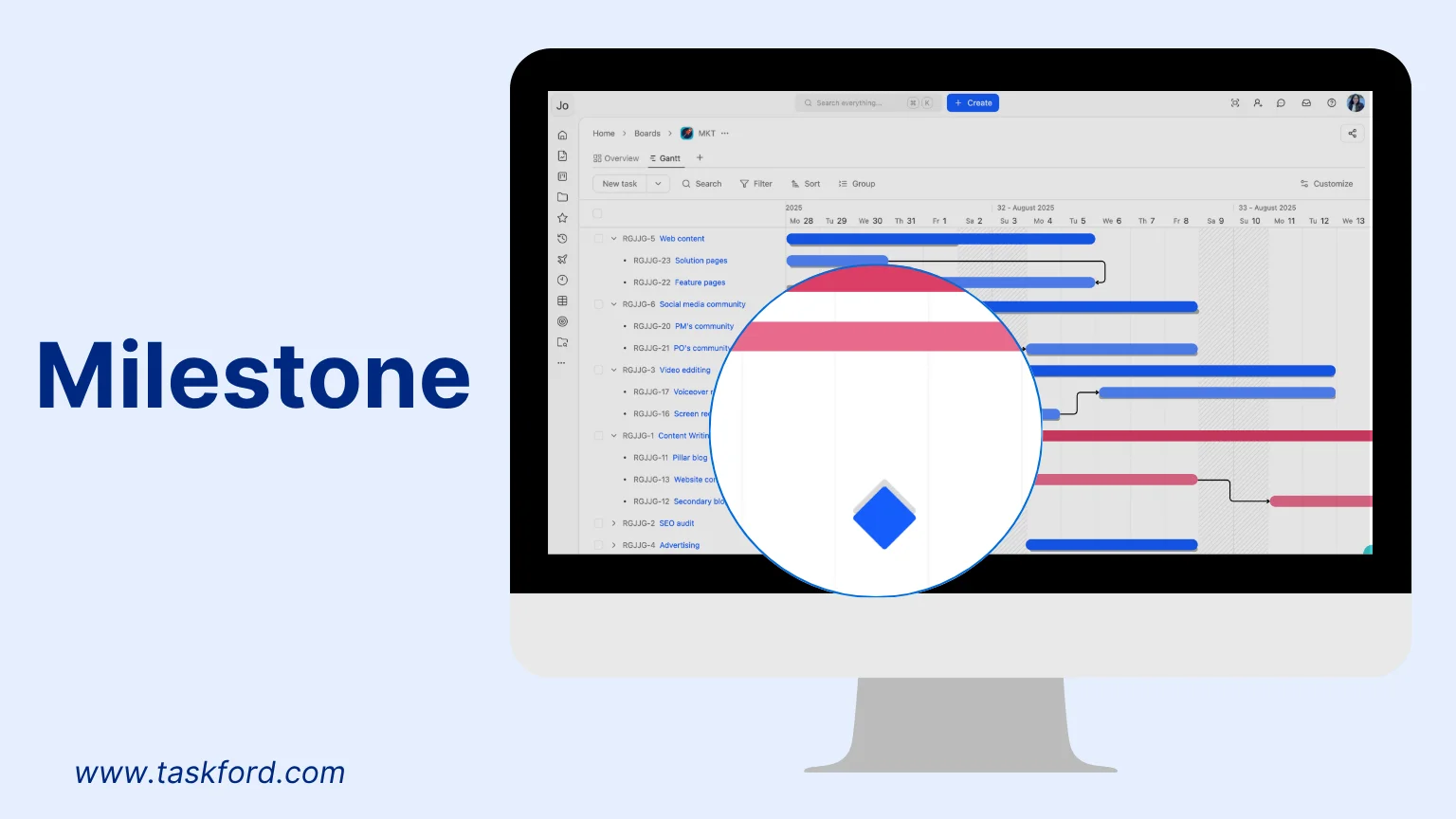
4. Roles and Responsibilities
Clarify who’s responsible for what. Define ownership clearly for each workstream or deliverable so everyone knows where to go for decisions, updates, or support.
You can briefly reference your RACI chart (Responsible, Accountable, Consulted, Informed) if you’ve prepared one, but keep this portion conversational.
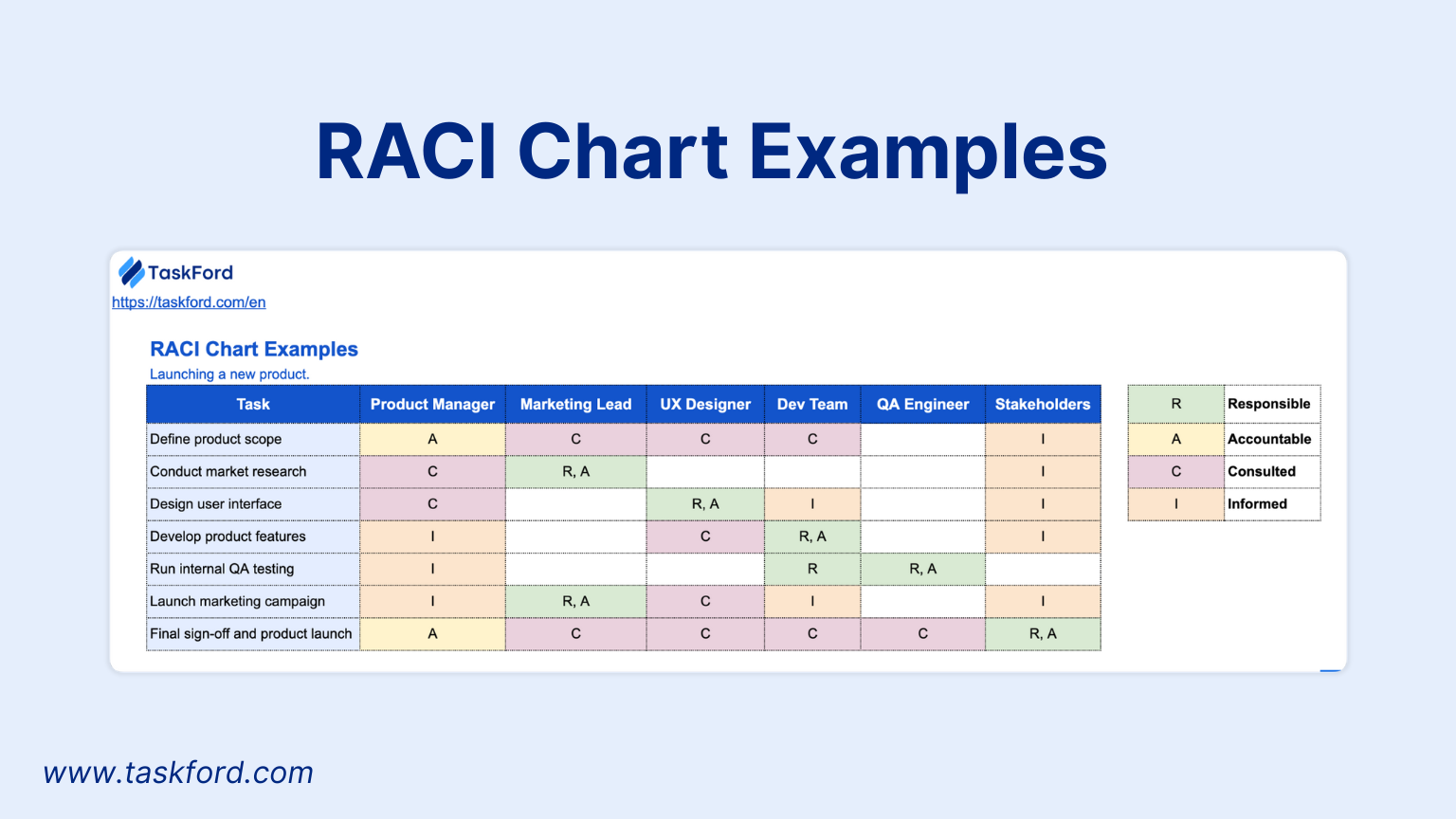
5. Communication Plan and Next Steps
Explain how the team will stay connected throughout the project. Agree on the main communication channels (e.g., TaskFord, or Slack), how often progress updates will happen, and what the next immediate steps are.
Wrap up by confirming:
- What actions need to be taken after the meeting
- Who’s responsible for each action
- When will the next check-in or review take place

6. Q&A or Open Discussion (Optional)
End with an open floor for questions, comments, or suggestions. This gives team members and stakeholders a chance to clarify anything uncertain or raise potential challenges early on.
💡Tip: For smaller projects, aim for a 45-minute session. For larger or multi-team projects, extend it slightly to include risk discussion or stakeholder expectations. The key is to balance structure with flexibility, enough detail to align everyone, but not so much that the energy fades.
How to Prepare for a Successful Project Kickoff Meeting
A successful project kickoff meeting doesn’t happen by accident — it’s the result of thoughtful preparation. Here’s a simple step-by-step way to get ready.
Step 1: Define Clear Objectives for the Meeting
Before you send a calendar invite, get clear on the outcome you want. Ask yourself: What should everyone know, agree on, or decide by the end of this kickoff?
It might be alignment on project goals, clarity on roles, or agreement on the project timeline and next steps. Having two or three concrete objectives helps you design a focused meeting instead of a loose conversation that drifts off track.
Step 2: Gather and Share Key Project Information
Next, gather the core documents and details that people will need to understand the project. This usually includes the project background, goals, scope, constraints, and a draft timeline.
Share these ahead of time so people can skim them before the meeting. If you’re using a tool like TaskFord, upload everything into the project space so the kickoff isn’t the only place this information lives.

Step 3: Invite the Right People
A good kickoff has the people who can move the project forward, not just a long list of attendees. Make sure the project manager, key team members, and main stakeholders are included. For client or cross-team projects, bring in the sponsor or client contact who can clarify expectations.
The goal is simple: everyone who needs to understand or shape the project direction should be in the room for this first conversation.
Step 4: Create and Share the Meeting Agenda
With your objectives and attendees in mind, put together a straightforward meeting agenda. It should outline the flow of the session — introductions, project overview, key deliverables and milestones, roles, communication, and next steps.
Share the agenda with the invite so people know what will be covered and can prepare questions or input in advance. During the meeting, keep the agenda visible so everyone can see where you are and what’s coming next.
Step 5: Prepare supporting visuals or materials
Even a simple project benefits from a few visuals. A one-page overview, a high-level timeline, or a quick org chart can make the conversation easier to follow.
You don’t need a polished slide deck; clarity matters more than design. The goal is to give people something concrete to look at while you explain the project, so they’re not trying to hold everything in their heads.
Step 6: Decide how you’ll set the tone
As the person running the kickoff, you set the mood for how the team will work together. Think about the message you want to send: open, collaborative, and focused.
A short opening — thanking people for joining, explaining why the project matters, and emphasizing that everyone plays a role in its success — goes a long way. It signals that this isn’t just another meeting; it’s the start of something shared.
Step 7: Plan your follow-up in advance
Finally, decide how you’ll capture and share what comes out of the meeting. Choose who will take notes, where they’ll be stored, and how you’ll communicate next steps.
After the kickoff, send a brief recap with key decisions, action items, owners, and deadlines, and link it back to your project workspace. That way, the momentum from the meeting turns directly into action.
Project Kickoff Meeting Template (Free Download)
To make your next project kickoff meeting easier to plan and run, we’ve created a free, ready-to-use template you can adapt for any team or project.
This Project Kickoff Meeting Template helps you organize your agenda, track participants, and capture important details, so you can focus on leading a clear and confident discussion.
The template is designed to guide you through every stage of the meeting from preparation to follow-up and can be customized for projects of any size or type.
🎁 Download your free Project Kickoff Meeting Template
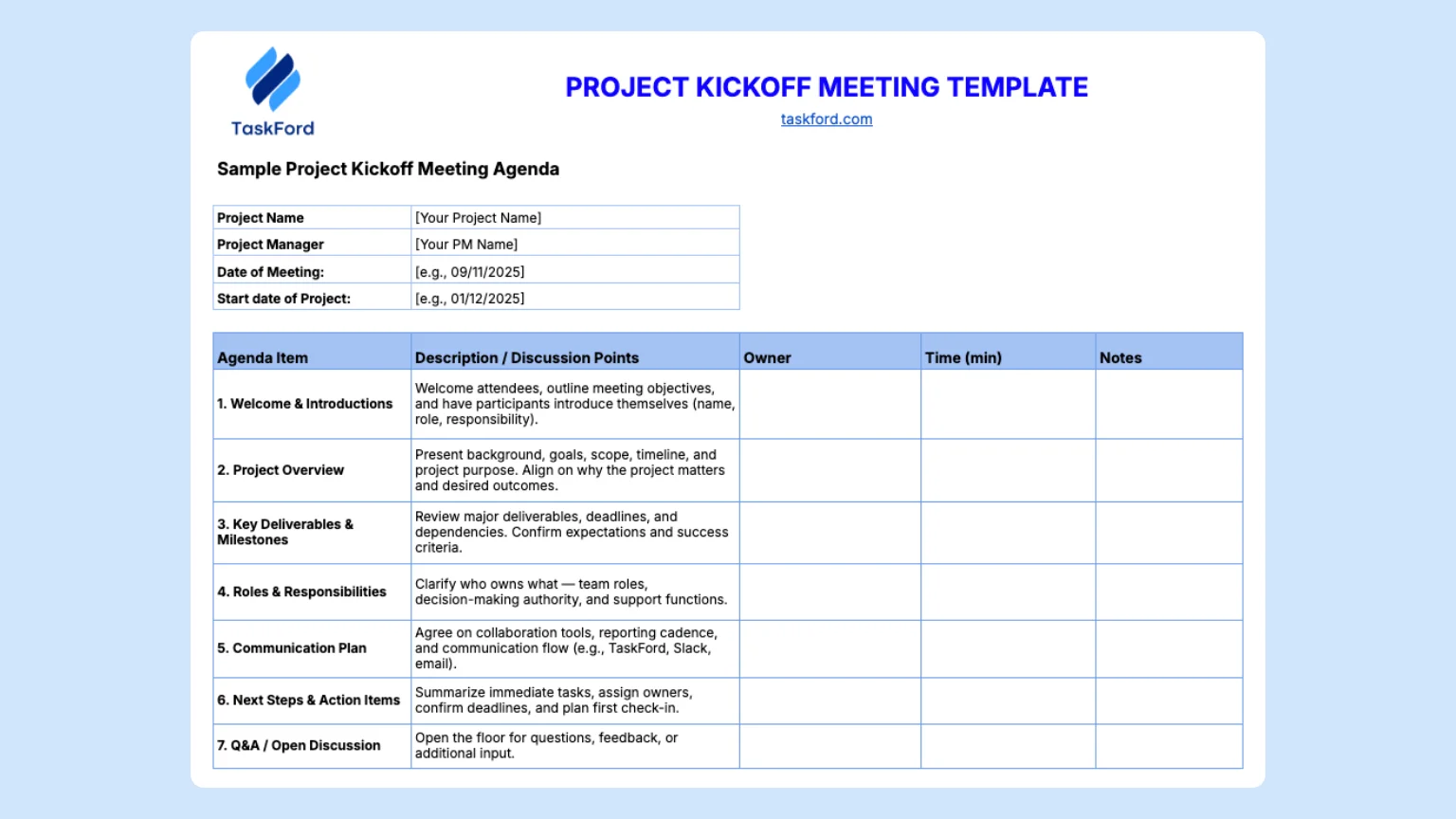
Final Thoughts
A well-run project kickoff meeting is more than a formality; it’s the foundation for project success. When teams start with clarity, alignment, and shared purpose, everything that follows becomes smoother and more focused.
By taking the time to prepare, define clear roles, and set communication plans early, you create an environment where everyone understands the goals and feels confident about their part in achieving them. Even a short, well-structured kickoff can prevent miscommunication, save time, and build momentum that lasts throughout the project.
Use the free Project Kickoff Meeting Template to plan your next kickoff efficiently. It will help you organize your agenda, track deliverables, and keep everyone moving in the same direction right from day one.
You May Also Like:
- What is a Project Milestone? A Detailed Guide to Effective Project Management
- WBS Gantt chart - A complete guide for Every Project Manager
- Project Development Plan How to Make One that Minimizes Risks (Free Template)
Subscribe for Expert Tips
Unlock expert insights and stay ahead with TaskFord. Sign up now to receive valuable tips, strategies, and updates directly in your inbox.